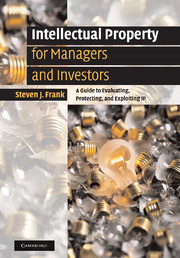 Intellectual Property for Managers and Investors
Intellectual Property for Managers and Investors 6 - Giving diligence its due
Published online by Cambridge University Press: 06 August 2009
Summary
Conducting an IP due diligence means investigating and evaluating a company's IP assets, practices, and risks. How strong are the patents? Will they help the company succeed? Do outsiders – an inventor's former employer or university, competitors bristling with their own patents – have any potential claims? Most commonly, IP due diligence precedes a transaction such as a round of venture funding, a merger, or an acquisition. Not only do professional investors hate to watch their money fund lawsuits, but also must measure the worth of IP assets in order to place a realistic value on prospective investments. A company's market projections may ultimately rest on its ability to secure a strong IP position, and, moreover, that position can itself prove a valuable asset even if the company fails.
Too bad, then, that IP due diligence can often seem a ritual ticking off of checklist entries rather than an effective search for meaningful issues. The grand menu of items that might be considered is enormous – if you do not believe it, feast on the banquet that ends this chapter. But performing an IP due diligence should not feel like being lost in an endless, expensive buffet, and, if it does, it's time to find a different restaurant. Context and common sense dictate the proper tasks. If a company's patents do not figure strongly into its business strategy (or an investor's estimation of what that strategy should be), why spend time reviewing them?
- Type
- Chapter
- Information
- Intellectual Property for Managers and InvestorsA Guide to Evaluating, Protecting and Exploiting IP, pp. 114 - 138Publisher: Cambridge University PressPrint publication year: 2006
